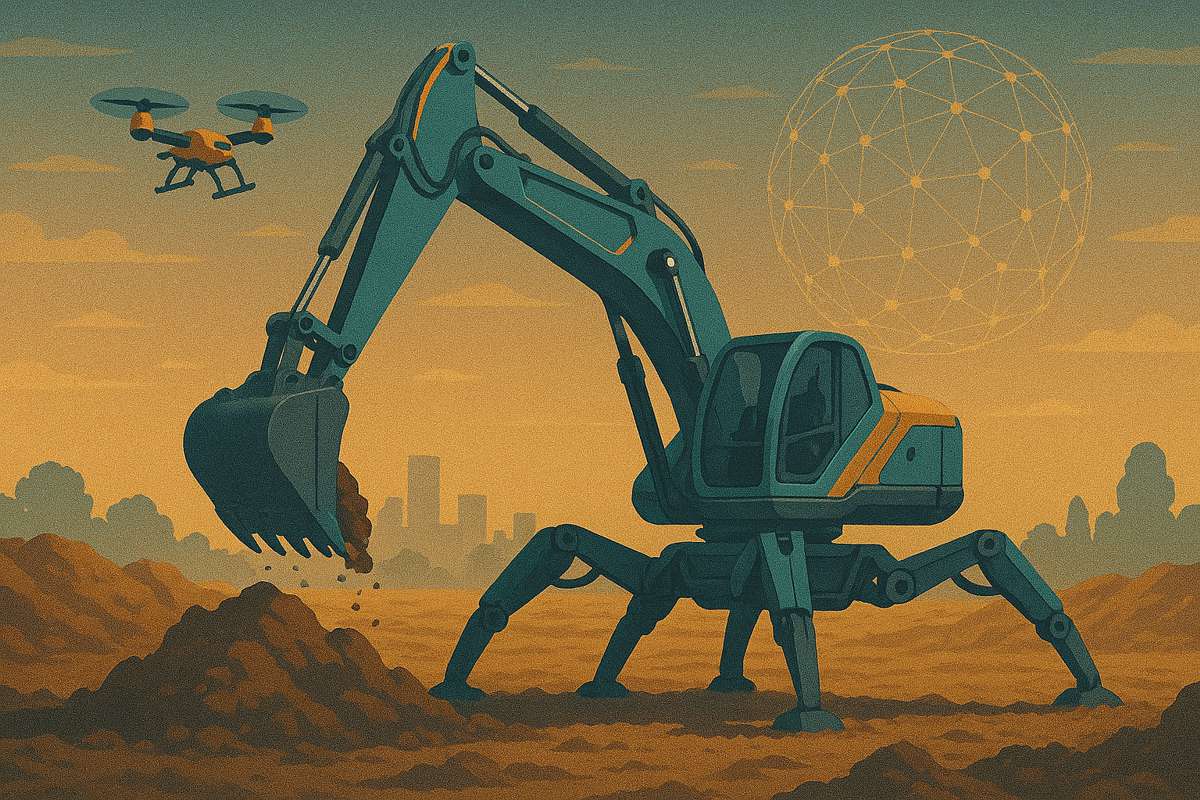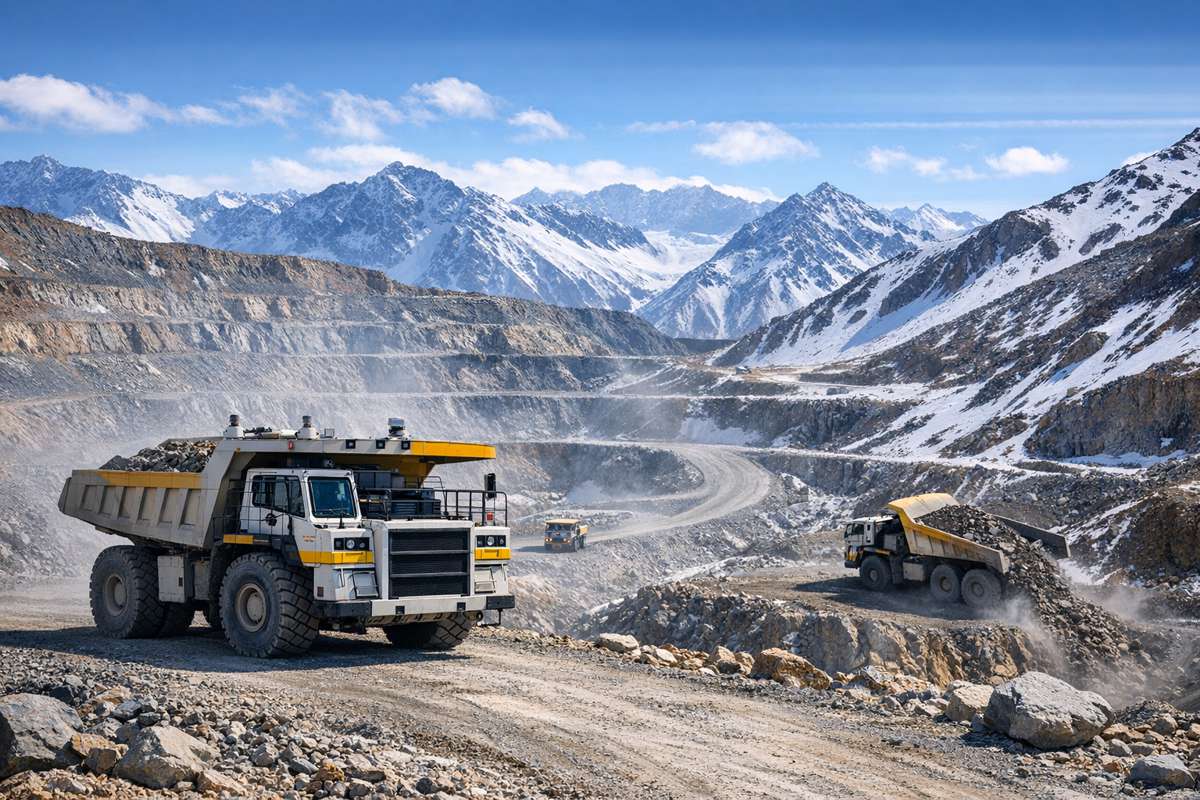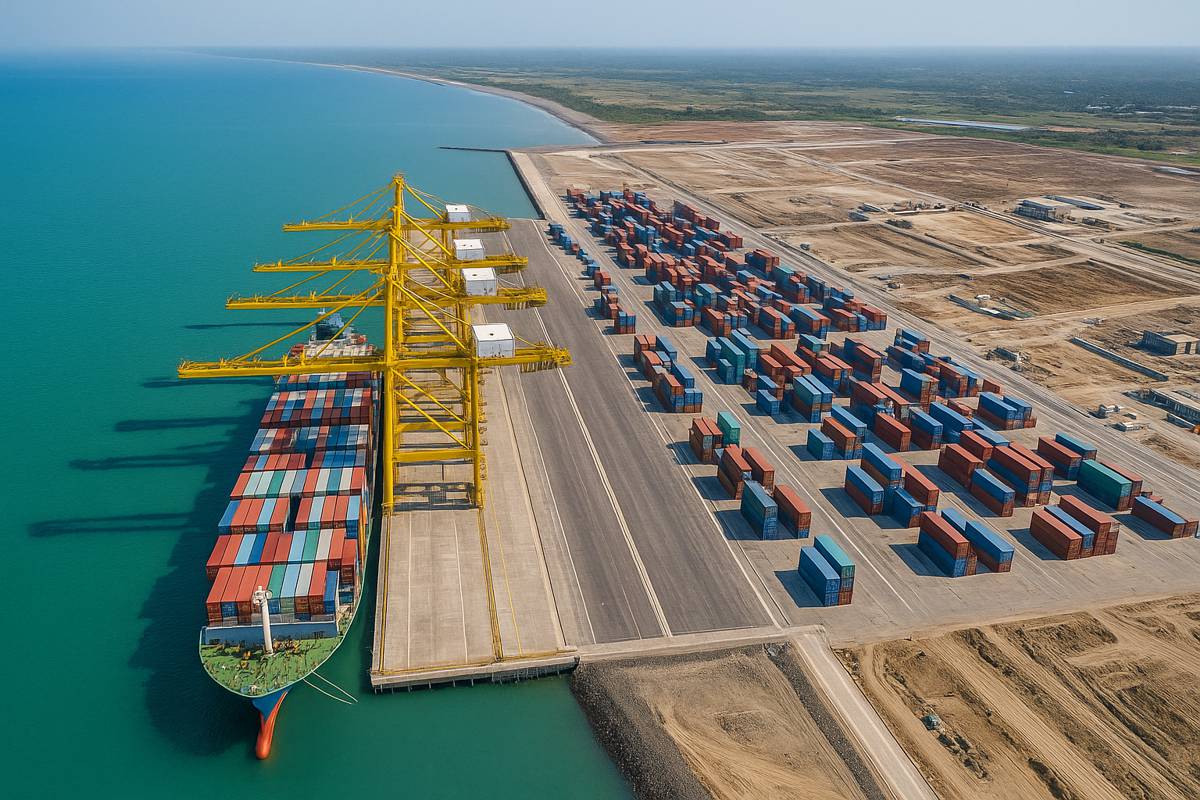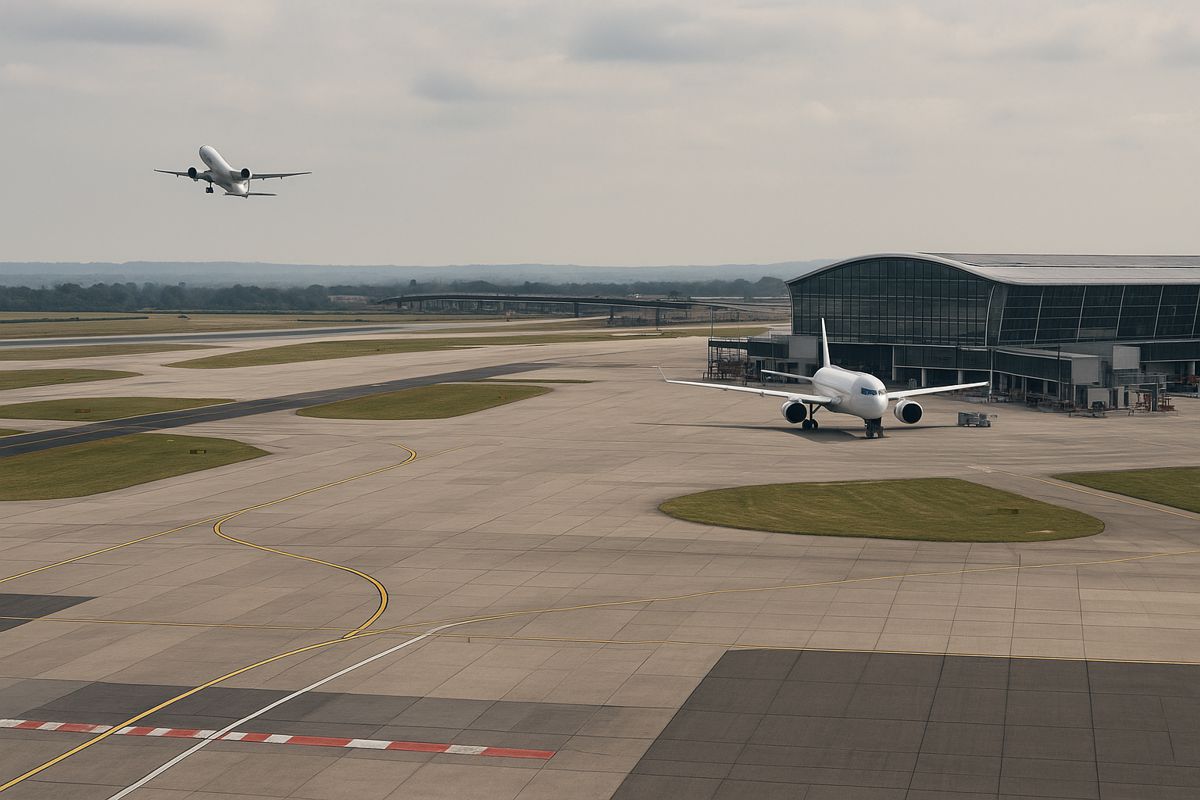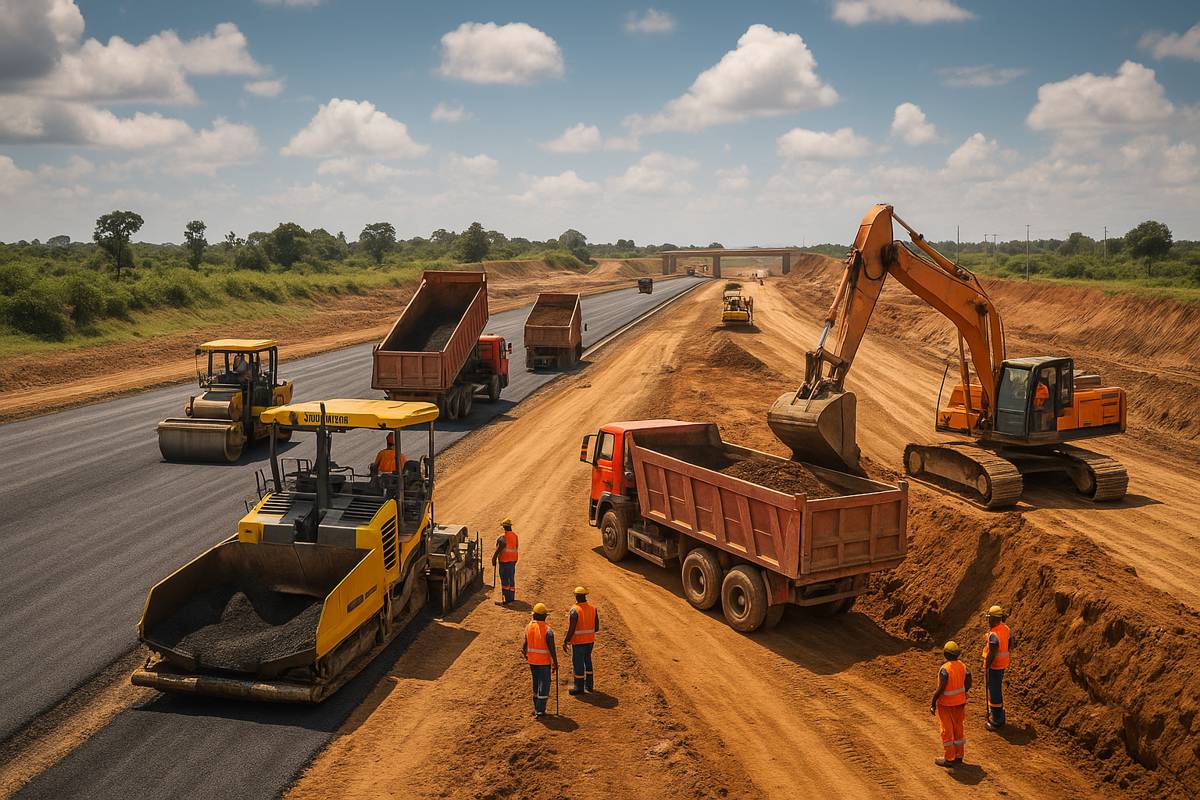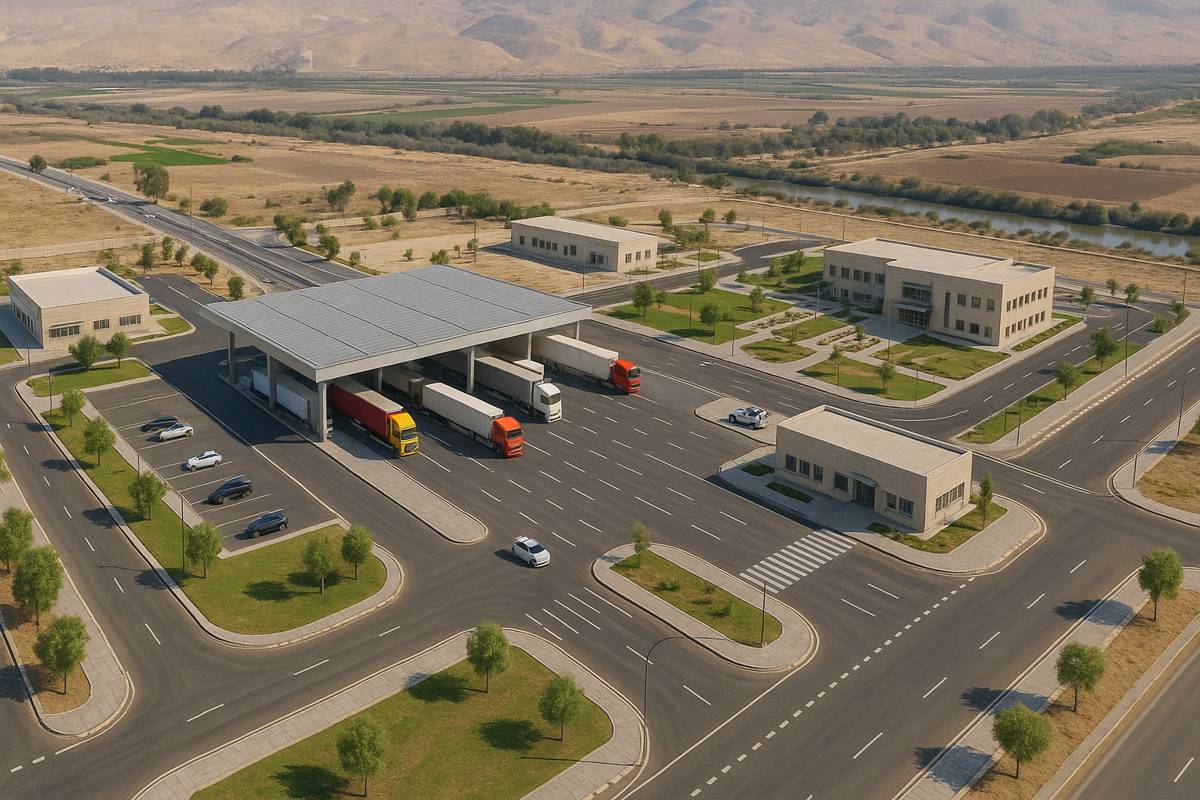The High-Tech Future of Construction Equipment
On a windswept jobsite in Western Australia, massive 250-tonne haul trucks rumble along in perfect formation without a single human at the wheel. Thousands of miles away in Sweden, a fleet of electric excavators and loaders quietly reshape a city block, emitting nothing but a faint whir. These aren’t scenes from science fiction – they’re real pilot projects showcasing how automation, electrification and artificial intelligence (AI) are beginning to revolutionise construction equipment. The traditionally rugged world of bulldozers and cranes is going digital and green, promising safer sites, higher productivity and new roles for workers.
Industry giants like Caterpillar, Komatsu, Volvo Construction Equipment and Liebherr are pouring innovation into making construction machines smarter and cleaner. From autonomous earthmovers guided by AI to cranes that diagnose their own maintenance needs, the construction site is rapidly evolving.
“Our goal is to help customers do more with less, tackle key industry challenges, and thrive in an increasingly complex industry. By incorporating AI into customer workflows, we’re enhancing decision-making and creativity, while also automating repetitive tasks to unlock new levels of efficiency,” says Aviad Almagor, VP of Technology & Innovation at Trimble. The transformation is underway across the globe – but it’s not without challenges.
This feature written for Construction Equipment Month at Highways Today explores the latest breakthroughs, regional adoption trends, and what it all means for companies and crews on the ground.
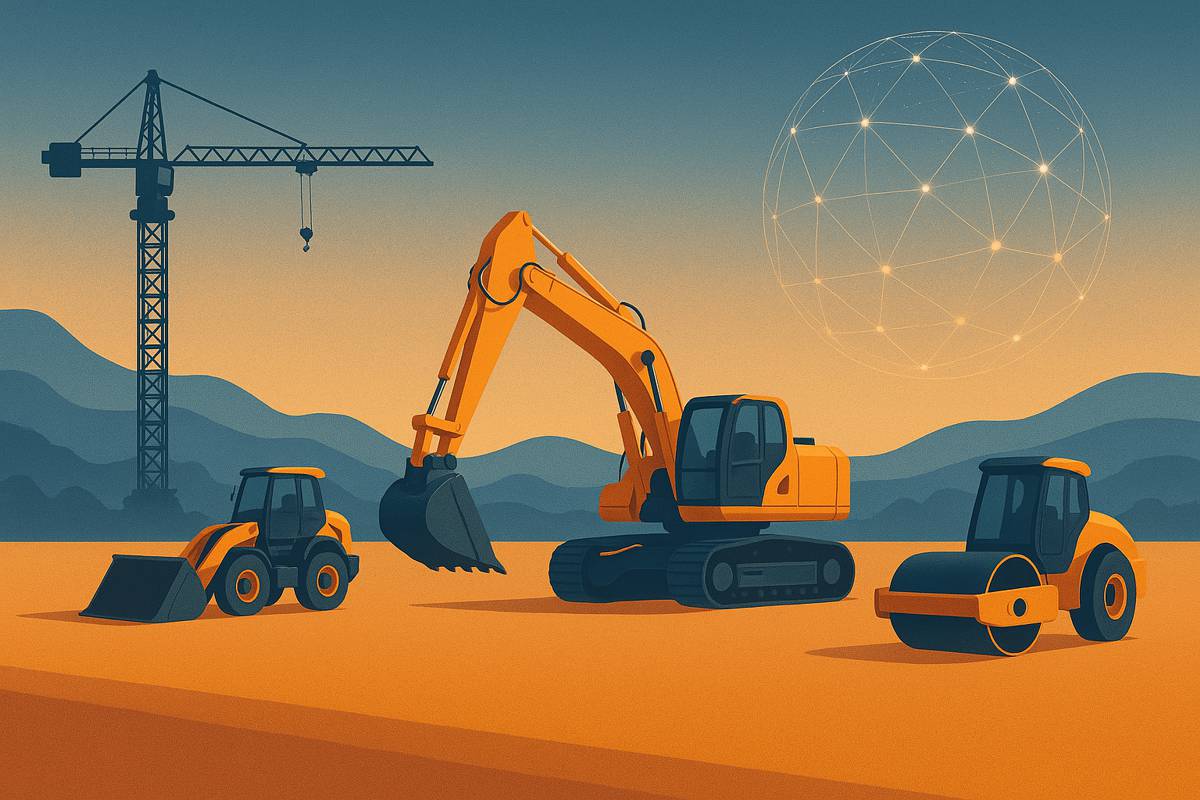
Automation, Electrification and AI Redefining Heavy Machinery
Construction equipment is getting an upgrade. Advances in sensors, software and energy storage are enabling machinery that can drive, dig and even “think” with minimal human input.
In this section, we delve into how leading manufacturers are pushing the envelope with automation, electrification and AI – complete with specific technologies and real-world case studies.
Caterpillar – From Autonomous Trucks to AI-Driven Dozers
Caterpillar, the world’s largest construction equipment maker, has been at the forefront of automation for years. Its giant mining trucks have operated autonomously in mines for over a decade, and that expertise is now filtering down to construction sites. Cat® Command remote operation consoles allow operators to control machines like bulldozers and excavators from a safe distance – even from an office trailer – keeping humans away from danger while boosting productivity. In one example, a single operator using Cat Command can oversee multiple bulldozers at once, effectively doing the work of several operators by “commanding” an autonomous fleet.
Caterpillar’s equipment is also bristling with assistive AI features. Modern Cat dozers come with 3D grade control that automatically adjusts the blade to follow design plans, eliminating the need for a human grade checker on the ground. Excavators have AI-powered “dig to grade” systems that stop the bucket at exact target depths, so even novice operators achieve expert-level precision. This not only saves time but also means less rework and material waste. Todd Farmer, a construction tech product manager at Caterpillar, notes that such automation helps new workers perform “as proficiently as experienced crews” from day one.
Safety is a major driver of Cat’s innovations. Construction remains one of the most dangerous industries – roughly one in five workplace fatalities occur on construction sites. Autonomous and semi-autonomous machines aim to change that. “About a fifth of accidents [on sites] are fatal. Autonomy makes equipment easier and safer to use,” explains Tim Crane, Caterpillar’s VP of Autonomy. Caterpillar is rolling out an AI-enhanced Collision Warning system that actually prevents a loader or truck from moving if an obstacle – say a worker or another vehicle – is detected in its path. Future versions will not just warn but automatically steer equipment to avoid accidents in real time. By essentially giving heavy machines a set of “eyes” and a brain, Caterpillar aims to virtually eliminate blind spots and struck-by incidents.
Electrification is the other pillar of Cat’s future strategy. At CES 2024 in Las Vegas, Caterpillar surprised attendees by showcasing a prototype battery-electric 950 GC wheel loader. This 20-tonne loader packs a 256 kWh battery and can fast-charge using industry-standard EV chargers. It promises the same breakout force and performance as its diesel counterpart – but with zero exhaust and much lower noise. Caterpillar expects to bring this electric model into production by 2025. The company is also developing charging solutions (like the Cat Dynamic Energy Transfer system) to manage power for mixed fleets of diesel and electric machines. Although Caterpillar faces competition from the likes of Volvo CE and Bobcat on electric equipment, Cat is leveraging its vast dealer network to pilot these technologies with customers now.
A case in point: Caterpillar recently deployed its first autonomous haul trucks in a North American quarry – the company’s inaugural foray into self-driving machines for the construction aggregates industry. Early results showed productivity jumped by nearly 30% when trucks operated autonomously, compared to traditional crewed operation. With over 550 driverless Cat mining trucks already in action worldwide, Caterpillar is now translating that success to earthmoving and roadbuilding projects. The message is clear – the era of AI-driven, self-propelled construction equipment has begun.
Komatsu – Smart Construction and Robotics Rise in Asia
Japan’s Komatsu, another industry titan, is taking a holistic approach through its SMARTCONSTRUCTION initiative. Launched in 2015, Smart Construction is a suite of digital tools connecting workers, machines and data across a jobsite. One marquee effort is a collaboration with NVIDIA to create real-time 3D visualisations of construction sites. By fitting machinery with NVIDIA Jetson AI computers, Komatsu enables a live digital twin of the site where the locations of equipment, workers and materials are tracked in 3D. Drones and cameras feed into this system, and AI algorithms identify personnel and hazards so that machines can automatically halt when people get too close.
“Future machines will perceive their surroundings and be continuously alert, helping operators work more efficiently and safely,” NVIDIA CEO Jensen Huang said of the partnership. This kind of always-on safety net is crucial in places like Japan, where an aging workforce and labor shortages have accelerated the push for jobsite automation.
Komatsu’s automation extends to the machines themselves. The company pioneered autonomous haul trucks in mining (branded FrontRunner AHS) and is now developing robotic construction equipment. Autonomous excavators that can dig trenches on their own have been trialled, and Komatsu’s dozers and graders come with advanced intelligent Machine Control (iMC) that automates blade movements. On select projects in Japan, robo-dozers prepare building pads with minimal operator input, supervised by operators from remote stations. This proved invaluable during COVID-19 restrictions and in disaster zones where sending crews was unsafe. Komatsu reports that automation has cut average earthwork times by 50% on certain Smart Construction pilot sites in Japan (internal case study data).
The company is also a leader in electric construction equipment, especially for the European market. At Intermat 2024 in Paris, Komatsu unveiled three new electric mini excavators (models PC20E, PC26E, PC33E) aimed at urban construction in Europe. These battery-powered minis produce zero exhaust – a major advantage for cities with strict emissions rules. Komatsu has partnered with Honda to develop micro electric excavators as well, and in late 2024 it announced a 13-tonne PC138E-11 electric excavator for Europe, equipped with a 225 kWh battery for a full work day. In mining, Komatsu demonstrated a massive 400-ton electric mining shovel that can reduce emissions by up to 95% using cable electrification. By electrifying equipment, Komatsu aligns with Europe’s climate goals and positions itself as a supplier of “safe, productive, smart and clean” machinery.
Notably, Komatsu’s Smart Construction platform now incorporates artificial intelligence for data processing. In September 2024, Komatsu – via its EarthBrain joint venture – integrated AI into its Smart Construction Edge device, which processes drone survey data. The AI can automatically strip out obstacles like machines or buildings from drone photogrammetry, producing clean 3D terrain models in minutes. “I’m extremely proud to launch this new version of Edge into multiple markets… we’re committed to helping professionals increase productivity to ultimately save time and money,” said Bart Vingerhoets, a senior manager at Komatsu Smart Construction. After a successful rollout in Europe, this tool allowed even non-specialists to create accurate site maps. For example, Belgian contractor CROES VS used the AI-driven Edge to keep projects on track when their chief surveyor went on leave – even the marketing manager could run drone surveys and get instant earthwork volumes with the push of a button. By leveraging AI to democratise complex tasks like surveying, Komatsu is showing how automation can augment humans on site rather than replace them.
Volvo CE – Pioneering Electric and Autonomous Machines in Europe and North America
Sweden’s Volvo Construction Equipment (Volvo CE) has staked its future on sustainability and smart technology. Electrification is a core focus – Volvo was among the first to commercially launch electric construction machines, beginning with compact excavators and loaders. Today, the company’s ECR25 Electric mini excavator and L25 Electric wheel loader are working on sites worldwide. In 2024, Volvo took a leap with the 23-ton EC230 Electric excavator, one of the largest battery-electric diggers deployed to date. Pilot projects proved its viability: in Los Angeles, Skanska tested an EC230 Electric for 90 days and saw hourly carbon emissions drop 66%, while operating costs fell 74% compared to a diesel unit.
“The cost savings are just as important because if these solutions don’t make financial sense in addition to the emissions reduction, adoption will lag,” notes Dr. Ray Gallant, Volvo CE’s Vice President of Sustainability & Productivity Services. Another trial with Sunbelt Rentals in California yielded 80% lower carbon emissions and 83% cost savings versus diesel over three months – an eye-opening confirmation that green machines can pay off.
Volvo CE has since made the EC230 Electric commercially available in North America, and it’s been put to work at a Florida recycling facility processing 100+ tons of material per hour. The electric excavator can run a full 8-hour day with a mid-shift quick charge, and operators report it “performs just as well as its diesel equivalent” . In Sweden, an EC230 Electric contributed to a pilot project that cut 1,808 tonnes of CO₂ emissions – part of an experiment towards entirely fossil-free jobsites. On that Stockholm site, electric equipment provided 23% of the carbon reduction, complemented by renewable fuels and recycled materials. Volvo’s vision of a net-zero construction industry is coming into focus one project at a time. “This project demonstrated that… the fuel savings and carbon reduction offset [the higher manufacturing footprint of the electric machine] in just over 800 hours of use,” Dr. Gallant adds, emphasising that over a machine’s life, going electric clearly yields a net environmental benefit.
Automation is the other side of Volvo’s high-tech coin. In September 2024 at its Volvo Days event, Volvo CE wowed observers by rolling out the CX01 autonomous asphalt compactor – a robot roller that can pave roads with no operator on board. The CX01 is an innovative hybrid-electric machine: it uses electric motors for movement and vibration, but carries a small diesel engine to charge onboard supercapacitors for extra power bursts. This design allows quiet operation and precise control. Volvo engineers envision packs of CX01 compactors working in concert on future road projects, coordinating their passes via vehicle-to-vehicle communication. AI would enable the rollers to measure pavement density and decide where to make another pass, without waiting for human instructions. It’s a glimpse of fully automated roadwork that could dramatically speed up paving jobs while improving quality (since the machines continuously optimise compaction).
Another headline-grabber is Volvo’s TARA autonomous haulage system, anchored by the TA15 electric dump truck. The TA15 is a 15-tonne capacity hauler that is completely driverless and battery-powered. “Production-ready” according to Volvo, these robo-haulers are already shuttling material in pilot programs on customer sites. Because they navigate predefined routes, they excel at repetitive tasks like hauling blasted rock from a quarry pit to a crusher. Volvo says a fleet of smaller TA15s can replace larger diesel trucks, keeping output high while eliminating emissions and operating 24/7.
“TARA enables you to downsize and replace larger diesel-powered vehicles with a fleet of autonomous electric Volvo TA15s capable of running 24/7,” reads the official release. “This not only helps you cut emissions and increase productivity, it will also help you right-size your machinery and optimize your hauling routes.” In other words, automation isn’t just about robots for robots’ sake – it’s about rethinking jobsite logistics entirely. Volvo’s approach could allow continuous operation with fewer interruptions (no lunch breaks or shift changes), all while achieving sustainability goals.
Volvo CE is backing these innovations with practical support. At the 2024 ACT Expo, it announced partnerships to expand charging infrastructure for off-road electric equipment, including portable Level 2 chargers for compact machines and high-voltage DC fast chargers for big equipment. The company knows that technology is only as good as its implementation on the ground. That means training, support and ecosystem development are part of the package (more on workforce and training later). By combining green powertrains with smart automation, Volvo CE is firmly positioning itself as a leader in the “build it clean, build it smart” movement on both sides of the Atlantic.
Liebherr – Mega-Deals in Autonomy and Alternative Energy
Liebherr, a German-Swiss manufacturer known for gigantic mining and earthmoving machines, is also pushing construction tech boundaries – particularly in mining, which often serves as a proving ground for construction equipment. In 2024, Liebherr announced a historic $2.8 billion deal with Fortescue Metals Group to develop and supply 475 zero-emission mining machines for Fortescue’s operations in Australia. The scale is staggering: around 360 of these will be autonomous battery-electric haul trucks, along with 55 electric excavators and 60 battery dozers. It’s touted as one of the world’s largest deployments of autonomous electric vehicles to date, and the largest equipment order in Liebherr’s 75-year history. The two companies even unveiled a prototype autonomous T 264 haul truck at MINExpo 2024, signalling that the technology is ready for prime time. By 2030, Liebherr and Fortescue aim to have a full zero-emission mining ecosystem operational, which will also be offered to other mining firms as a turnkey solution. For construction at large, this partnership is a beacon: if hundreds of 240-ton trucks and huge dozers can run on batteries and AI in a mine, there’s little doubt that smaller construction machines will follow suit on building sites and highways.
Beyond mining, Liebherr is bringing advanced tech into construction equipment used in civil projects. The company has introduced assistance systems for its range of excavators and cranes to improve safety and ease of use. For example, Liebherr’s latest hydraulic excavators can be equipped with load-sensing intelligent hydraulics that adapt in real time to the work demands, and with semi-automatic functions for trenching and lifting that prevent human errors (like over-digging or tipping). Liebherr has also pioneered a unified digital platform called INTUSI (short for Intelligent User Interface) that is being rolled out to seamlessly integrate machine controls, BIM data, and jobsite management tools. INTUSI essentially turns heavy equipment cabins into smart cockpits with touchscreens and connectivity, so operators have real-time data on everything from grade plans to fuel efficiency at their fingertips.
On the electrification front, Liebherr isn’t just looking at batteries. The company is exploring hydrogen fuel cell technology for heavy equipment as well, given the high energy demands of large machines. In 2023, Liebherr presented a prototype hydrogen-powered excavator and announced R&D into hydrogen combustion engines for its cranes. While battery power works well for smaller machines or those that can frequently recharge, hydrogen could offer a zero-emission solution for long-duration tasks or very high power equipment where batteries alone might be impractical. Liebherr’s strategy seems to be hedging bets across batteries, hydrogen, and even grid-connected electric options (like trolley-assist trucks or cable-powered drilling rigs) to cover the wide range of use cases in construction and mining.
In early 2025, Liebherr partnered with a European construction consortium to pilot an “electric construction site” concept outside Oslo, Norway. They supplied electric mixers, cable-powered tower cranes, and battery excavators, all coordinated through a central energy management system. The project reported a 70% reduction in onsite CO₂ emissions and markedly lower noise, improving relations with the local community (per internal project report). Such real-world trials are helping to validate that these technologies can meet the rugged reliability standards contractors demand.
In summary, the major equipment OEMs each bring their flavour to construction’s high-tech evolution – Caterpillar with integrated autonomy and jobsite AI, Komatsu with digital platforms and robotics, Volvo with clean energy and systems thinking, Liebherr with a bold bet on scaling electric fleets. Together, they are redefining what heavy machinery can do.
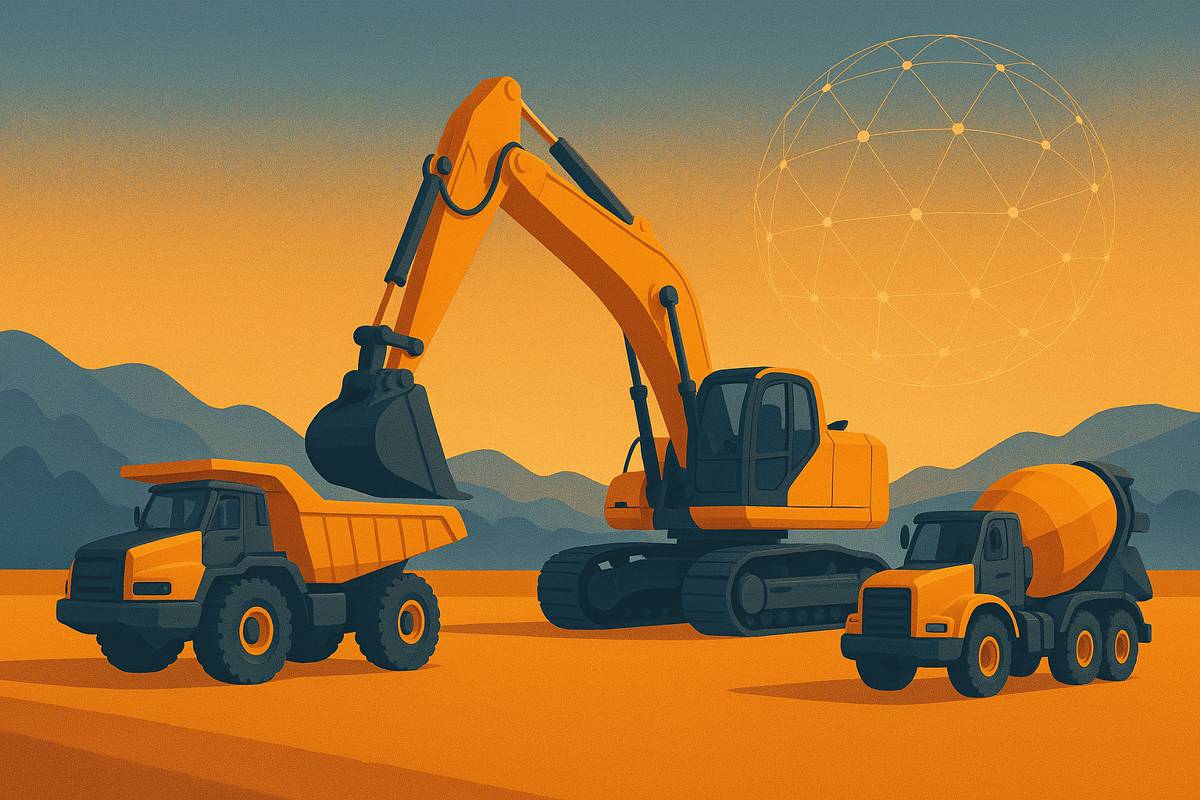
Global Perspectives – Innovation on Jobsites from America to Asia
Technology adoption in construction is not one-size-fits-all – it varies widely by region. Regulatory environments, labour dynamics, and market needs influence how quickly and in what ways new equipment tech is embraced.
Here’s a look at how the future of construction equipment is playing out across North America, Europe and the Asia-Pacific.
North America – Safety and Productivity Drive Adoption
In the United States and Canada, construction firms are turning to automation and AI largely to boost productivity and tackle labour shortages, while also improving safety. The US construction sector has faced a chronic shortfall of skilled workers – in 2023, the Associated Builders and Contractors estimated a deficit of half a million workers needed to meet demand. This gap has made technologies like autonomous earthmoving equipment very appealing. Contractors in North America have been early adopters of robotic bulldozers and haul trucks, often first proven in mining. For instance, several large quarries in Arizona and Texas are now using autonomous hauling systems (from Caterpillar and Komatsu) to keep aggregates flowing to concrete and asphalt plants. These sites report higher output and lower costs per ton, even as they struggle less with hiring drivers for remote locations.
Safety is a powerful motivator as well. Regulatory pressure from OSHA and a risk-aware culture mean that if a robot can do a dangerous task, North American firms want to let it. That’s one reason remote-controlled demolition robots (like Brokk machines or Husqvarna’s DXR line) have gained traction for tasks such as concrete chipping and nuclear plant decommissioning – removing humans from harm’s way. On highway projects, contractors are exploring “autonomous crash trucks” that serve as mobile crash barriers in work zones without putting a driver in danger; one such vehicle, developed by Colas in collaboration with Kratos Defense, has been tested in Florida and received interest from several state DOTs.
Another area where North America leads is connected fleet management. Major rental companies and large contractors aggressively use telematics and AI-driven analytics to optimise equipment use. “Equipment telematics is essential for the construction industry in 2025, enabling companies to monitor and manage their machinery in real-time,” notes a CONEXPO industry expert. By tracking everything from idle time and fuel burn to hydraulic temperatures, firms can implement predictive maintenance and avoid costly breakdowns mid-project. One Texas-based earthmoving company integrated AI-based predictive maintenance across its 100+ piece fleet and cut unplanned downtime by 25%, according to Hexagon’s industry case studies. Uptime is money, and North American contractors – who often operate on thin margins – are increasingly data-driven in pursuit of efficiency.
That said, the sheer diversity of the North American market means adoption is uneven. Tech-forward companies are running pilot projects with autonomous dozers on solar farm developments, using Boston Dynamics’ Spot robots for site progress scans, and flying drones daily for volumetric measurements. Meanwhile, smaller contractors might still be manually tracking equipment hours with clipboards. Cost remains a hurdle, so many firms dip their toes via rentals or leasing of advanced equipment. The good news is that as more data emerges proving the ROI of these technologies (from fuel savings, fewer accidents, etc.), acceptance is growing. The recent $1.2 trillion US infrastructure bill has also spurred interest – with so many projects in the pipeline, contractors know that those who leverage automation and AI may have a competitive edge in delivering faster and safer results.
Europe – Green Construction and Digitalisation Leading the Way
Across Europe, innovation in construction equipment is strongly influenced by sustainability goals and strict regulations. The EU’s push for decarbonisation has led to city-level bans on diesel machinery in some places, accelerating the adoption of electric equipment. Northern Europe in particular is ground zero for electric construction fleets. Oslo, Norway and Copenhagen, Denmark have both mandated zero-emission construction sites for public projects in coming years, prompting contractors to deploy battery-powered excavators, loaders, and generators. Volvo CE’s electric machines have found a ready market here, as have models from Wacker Neuson, JCB, and others. In the UK, Case Construction Equipment’s sustainable roadshow in 2024 – featuring an all-electric line-up of diggers and loaders – drew large crowds of operators and site managers curious about the new gear. This hands-on exposure is building comfort and skills with electric machinery among the workforce, easing the transition from diesel.
Europe also places a premium on precision and digitalisation. Technologies like machine control (automated grading systems), BIM integration, and telematics are widely used on large projects. In advanced markets like Germany, France and the UK, it’s increasingly common for an excavator operator to work with a digital plan loaded into the cab’s tablet display, guiding every bucketful of earth. Companies like Leica Geosystems (part of Hexagon) and Trimble have equipped thousands of machines in Europe with GPS and laser-guided control systems that dramatically reduce errors. A European contractor that adopted 3D machine control across its fleet reported finishing road subgrade prep 30% faster than before, with near-elimination of rework.
Another European strength is in integrated platforms – tying together data from various sources to manage the entire jobsite. For example, French construction giant VINCI developed an in-house digital platform that combines telematics from equipment, drone survey data, and scheduling software, all in one dashboard for project managers. This concept of the connected, orchestrated jobsite is more advanced in Europe partly due to collaboration between equipment makers and tech firms. Komatsu’s Smart Construction, as noted, made a big splash in Europe by rolling out AI-powered drone data processing to multiple countries. European contractors have been keen adopters of such tools: the case of Belgium’s CROES VS using Komatsu’s AI drone surveys to bridge a staffing gap is a great example of pragmatism – technology stepping in to solve real problems (in this case, a surveyor shortage).
Labour concerns in Europe also differ. Rather than acute shortages, the issue is often an aging workforce and attracting young talent into construction. Automation and high-tech equipment are being positioned as a solution to make construction a more attractive, “cool” industry for younger generations. In the UK, organisations like Innovation 2050 are demonstrating VR simulators and remote-controlled equipment at career fairs, giving students a taste of the futuristic tools they might use. Unions and industry groups in Europe tend to support new technology when it’s framed around improving safety and ergonomics – for instance, reducing manual heavy lifting or exposure to vibrations and fumes. Consequently, one sees more collaborative development of standards and best practices. The European Union’s Agency for Safety and Health at Work has even funded studies on exoskeletons to assist aging workers and on cobots (collaborative robots) for repetitive tasks, ensuring humans remain central to the process.
In summary, Europe’s construction tech evolution is green, digital, and human-centred. Emissions-free equipment and data integration are top priorities, and there’s a general ethos that technology should augment workers, not simply cut headcount. This aligns well with Europe’s social values and regulatory climate, setting a model for sustainable, high-tech construction.
Asia-Pacific – Leapfrogging with Robotics to Tackle Labour Gaps
The Asia-Pacific region presents a mixed but dynamic picture. Japan and South Korea are leaders in construction robotics and automation, driven by severe labour shortages and a cultural openness to robots in daily life. Japan’s aging construction workforce (average age nearing 50) has forced companies to automate or face declining capacity. This is why Komatsu launched Smart Construction and why Japanese contractors have experimented with anything from robotic rebar tying machines to autonomous concrete finishers. Obayashi Corporation (one of Japan’s big general contractors) famously developed a robotic system to assemble rebar cages for bridge columns, reducing strenuous manual work. Shimizu Corporation, another Japanese contractor, built a prototype dam in 2022 almost entirely with autonomous or remote-controlled machinery, cutting required manpower by 70%. Such projects illustrate how “future jobsite” concepts are being tested in real projects in Japan more than perhaps anywhere else. Notably, the Japanese government supports these initiatives through its i-Construction program, which promotes ICT (information and communication tech) on sites and even offers subsidies for adopting proven automation.
Meanwhile, China is rapidly adopting construction technology at scale. Chinese construction firms have embraced drones, 3D printing of buildings, and prefab construction in a big way. When it comes to heavy equipment, Chinese OEMs (Sany, XCMG, Zoomlion, etc.) are catching up with Western counterparts on automation and electrification. In 2023, XCMG launched an autonomous road roller and demonstrated a platoon of self-driving dump trucks in a mine. The sheer volume of construction in China provides a massive testing ground – for instance, on a single megaproject building a new city, thousands of machines can be networked and optimised. There are reports of AI algorithms used in China to schedule and dispatch equipment fleets on megaprojects, dynamically adjusting the number of trucks or excavators at work to minimise idle time. Additionally, Chinese cities are leveraging IoT for smart infrastructure – construction equipment in smart city projects might come with sensors that integrate into the city’s digital twin, allowing authorities to monitor construction progress and environmental compliance in real time.
Elsewhere in Asia-Pacific, Australia stands out for its use of autonomous mining equipment (like Rio Tinto’s well-publicised autonomous train and truck operations). Australian contractors are beginning to bring that mining know-how to civil construction, especially in vast, remote areas where skilled operators are scarce. One example is an Australian highway project in 2025 that used automated graders and rollers (supervised by Trimble’s site systems) to operate longer hours and reduced the schedule by several weeks, all while coping with a lack of local operators.
Southeast Asia is at an earlier stage but catching up. Singapore mandates productive technologies – the government has a “Construction Industry Transformation Map” that explicitly calls for DFMA (Design for Manufacture and Assembly) and robotics to reduce labour needs. The tiny city-state has hosted trials of autonomous excavators for digging utility trenches and is pushing construction firms to adopt AI-based project management tools. Countries like Malaysia and Indonesia, on the other hand, still rely on plentiful manpower, but even there, large firms are investing in telematics to better manage their equipment fleets across widespread sites (often to combat fuel theft and improve maintenance).
Overall, Asia-Pacific spans extremes: from highly advanced robotics in Japan to basic mechanisation in developing regions. But the trend is upward everywhere. Labour demographics and sheer demand (especially in India and China) mean technology must fill the gap. Asia is also unique in that urban mega-projects (think of building entire smart cities or massive transit systems) provide a sandbox to deploy the latest construction tech at unprecedented scale. By 2030, it’s expected that many of the world’s most technologically advanced construction sites will be in Asia, whether it’s a Japanese smart highway project run by AI or a Chinese city build with fleets of home-grown autonomous machines.
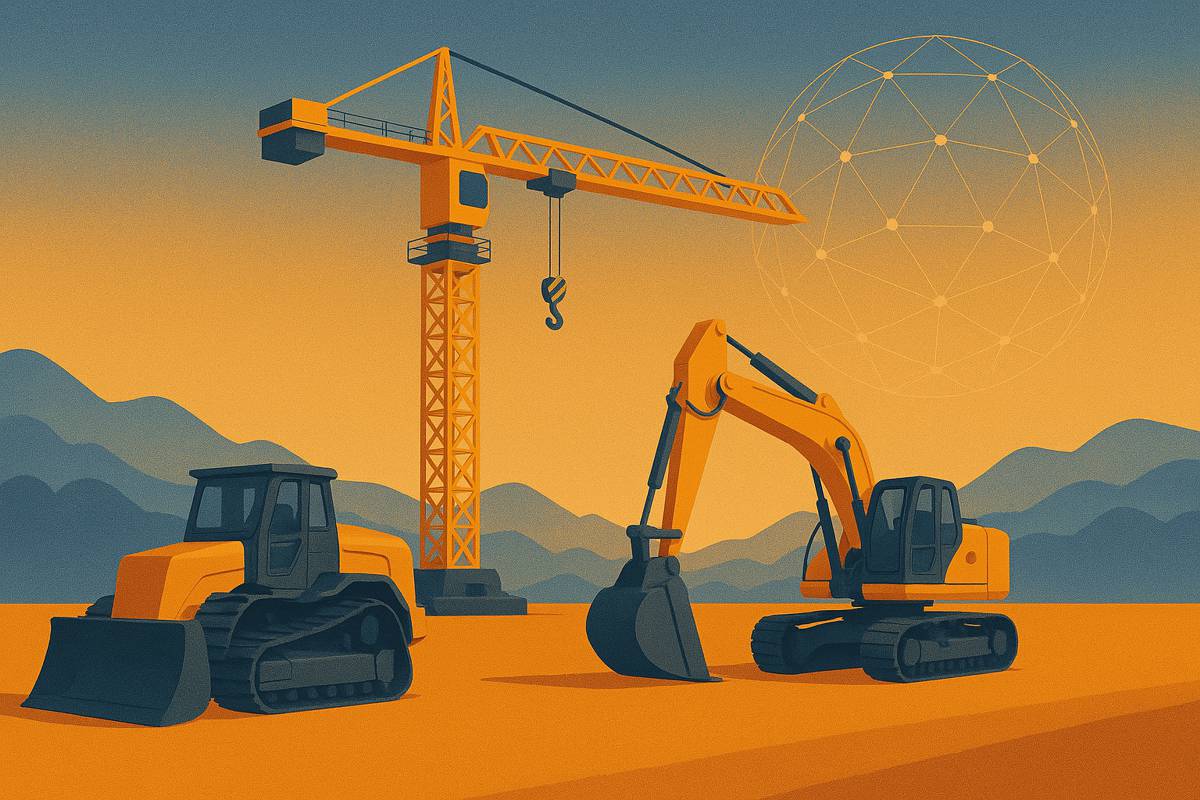
Smarter Maintenance and Operations with AI and Predictive Analytics
Beyond the flashy robots and electric motors, a quieter revolution is happening under the hood (sometimes literally): the integration of AI-driven analytics into construction equipment maintenance and fleet management. Modern machines are not only automated in how they operate; they’re also getting smart about when and how they need care, and how to optimise their own performance. This is where tech providers like Trimble, Hexagon, and NVIDIA – often behind the scenes – play a key role alongside the OEMs.
Predictive maintenance is one clear win enabled by AI. Instead of following fixed service intervals or reacting to breakdowns, AI systems analyse data from sensors on equipment to predict faults before they happen. For example, sensors on a bulldozer’s engine and hydraulic system continuously feed temperature, pressure, and vibration data to the cloud. Machine learning models crunch this data and might detect an anomaly – say a subtle vibration pattern indicating a developing issue in a pump. The system then alerts the fleet manager to inspect or replace that part at the next convenient downtime, preventing an unexpected failure that could halt a project. According to an analysis by Hexagon, implementing IoT sensors and AI analytics can reduce equipment downtime by 25% while also improving safety through real-time monitoring. Many large contractors and rental companies report that predictive maintenance has saved them millions by avoiding catastrophic breakdowns (think of a crane out of service waiting for a major repair) and extending component life by fixing problems at the optimal time.
One industry expert likens predictive analytics to a “digital doctor” for heavy equipment. It listens to the machine’s heartbeat and catches health issues early. In practice, companies like Komatsu and Caterpillar partner with tech firms or have internal divisions for these analytics. Caterpillar’s dealers offer services where they monitor a customer’s fleet via the Cat VisionLink® platform, which uses predictive algorithms to flag issues – sometimes dispatching a field technician with the right part before the customer even knew something was wrong. Komatsu, through its KOMTRAX telematics, similarly funnels data to centres that use AI to spot anomalies. It’s common now for excavators or haul trucks to be shipped with hundreds of built-in sensors; the real advancement is the AI that learns what “normal” looks like for each machine and can warn when something’s off.
AI is also enhancing operations and decision-making on the jobsite. Fleet management software powered by AI can make suggestions like: “Machine 23 (excavator) is underutilised this week, consider reallocating it to Site B where it could finish the work quicker,” or “Based on payload data, Truck 5 is consistently 10% underloaded – perhaps operator training or a route change can improve efficiency.” These insights come from pattern recognition across big data sets that humans alone would struggle to analyse. For instance, UK-based infrastructure firm Balfour Beatty used an AI tool to optimise earthmoving on a highway project, balancing the number of trucks and excavators in real time to minimise wait times. They reported saving roughly 20% in fuel and time on that task.
Tech giants are deeply involved here. Trimble, known for its precision GPS and construction software, has incorporated AI into products like WorksOS and Fleet Manager to do exactly these optimisations. Trimble’s recent platform updates include dashboards that predict maintenance needs and even automate the scheduling of machines between sites to meet project timelines most efficiently. Trimble also showcased LiveCount AI for office workflows – using AI to count symbols on digital blueprints automatically – which hints at how much repetitive “thinking” work AI can handle, freeing humans for higher-level planning. As Almagor from Trimble put it, AI in construction is about helping customers “do more with less” and thrive despite complexity.
Hexagon (through its Leica and other divisions) provides many of the “brain” components behind OEM systems. Its software can take in telematics feeds from mixed fleets (different brands) and apply machine learning to provide a unified view of operations. Hexagon’s safety systems, for example, can predict and alert when a machinery-operator interaction might become unsafe (like predicting an excavator’s swing path intersecting with a known ground worker’s location device). By fusing sensor data, AI can create dynamic geofences – virtual safety zones that adapt as conditions change, warning both the machine and workers if a breach is imminent.
Then there’s NVIDIA, a company most associate with graphics cards, but which has become a linchpin in industrial AI. NVIDIA’s chips and software are often the backbone of the AI onboard autonomous machines. Many autonomous construction equipment prototypes – like the aforementioned Komatsu systems – use NVIDIA Jetson AI modules to process camera feeds and LiDAR data on the edge, meaning on the machine itself in real time. NVIDIA has also worked with start-ups and OEMs to enable construction simulators and digital twins. Using the NVIDIA Omniverse platform, companies can create a physics-accurate virtual model of a construction site, then run AI agents (digital versions of dozers or trucks) to simulate operations and find optimal plans. Imagine being able to test different site layouts or construction sequences overnight in a simulation with dozens of virtual robots – then take the best plan and implement it in reality the next day. This is becoming possible and is especially useful for very complex projects.
Another practical AI use is in vision systems for safety. Companies like SafeAI and Built Robotics retrofit older machines with AI cameras and autonomy kits. These use computer vision (often powered by NVIDIA GPUs) to detect people, obstacles, even the edge of a trench, and can intervene to stop a machine if needed. In fact, Caterpillar’s upcoming Motion Inhibit system for loaders – which keeps a loader halted until a detected obstacle is cleared – is a direct result of such vision tech. The collaboration between AI firms and heavy equipment is only growing: we see partnerships like Volvo with NVIDIA (for autonomous driving tech transfer) and Hyundai Construction Equipment with IBM (for AI-based asset management).
Crucially, the data to fuel these AI models is now widely available thanks to the explosion of IoT on worksites. Every modern machine can produce gigabytes of data per day. The challenge is turning that into actionable intelligence. That’s why construction companies are hiring data analysts and why equipment dealers are offering analytics as a service. The result is a construction process that is increasingly proactive rather than reactive – maintenance is planned at the optimal time, operations adjust dynamically to conditions, and managers get decision support from their AI copilots.
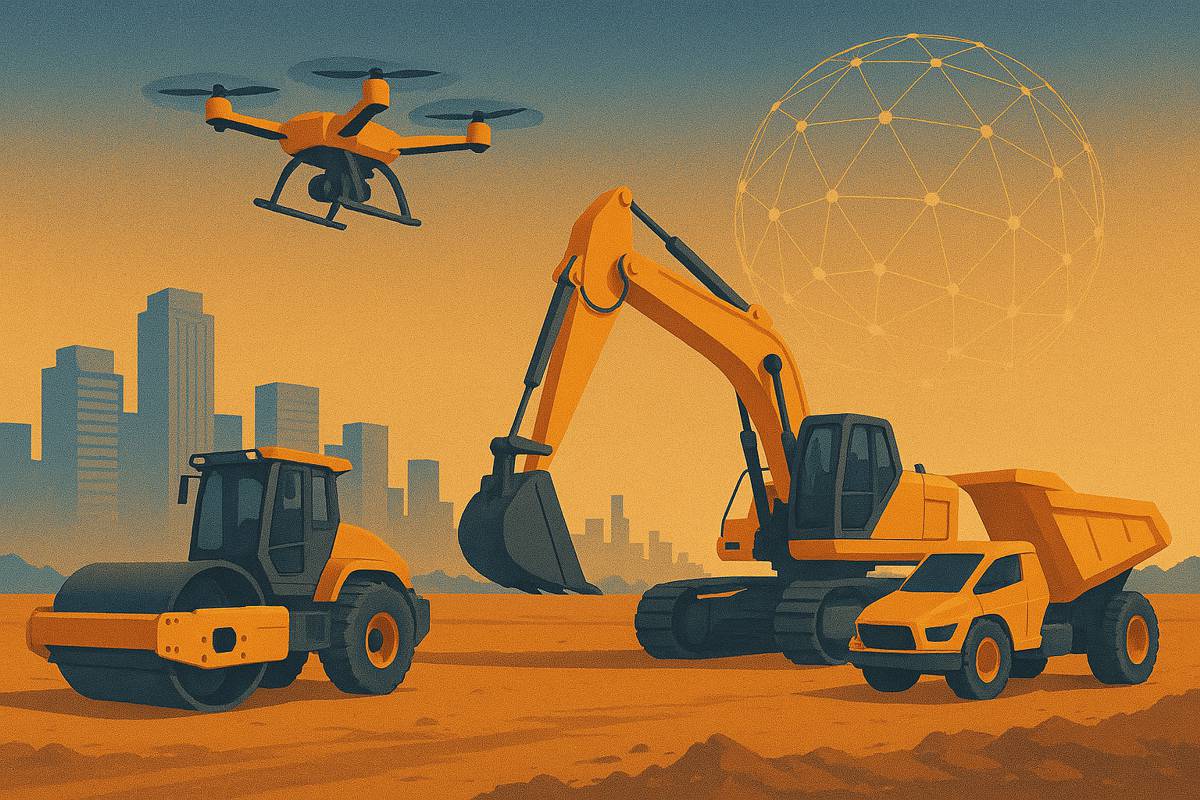
Connected Job Sites – IoT and Telematics Transforming Construction
Walk onto a cutting-edge construction site today and you might sense a hidden layer of activity beyond the roar of engines and clanking of steel. That invisible layer is a constant stream of data linking people, machines, and even materials. The Internet of Things (IoT) – a network of sensors and smart devices – combined with advanced telematics is creating truly connected, data-driven job sites.
Telematics, essentially the telemetry of vehicular systems, has become commonplace in heavy equipment. Almost all new machinery comes with some form of telematics unit installed. In 2023, the global installed base of active OEM telematics systems on construction equipment reached 6.8 million units, and it’s expected to nearly double to 12.1 million by 2028. Each of those units is like a digital heartbeat monitor for the machine, transmitting data on location, engine hours, fuel consumption, load weights, and more. The reason so many companies are investing in this is clear: “In a world where data is everything, telematics is how to stay ahead, save money and keep projects running smoothly,” notes a CONEXPO-CON/AGG expert.
Here are several ways IoT and telematics are making construction smarter:
Real-time Fleet Visibility: With GPS trackers on every machine, a manager can see where all equipment is on a map, in real time. No more guessing or radioing around to find the nearest loader – the data is at their fingertips. This visibility also extends to preventing theft or unauthorised use; geo-fencing features can alert if a machine leaves the site perimeter or operates outside scheduled hours.
Optimised Equipment Utilisation: Telematics helps identify under-utilised equipment. If a $500,000 excavator is only running at 40% utilisation on one site, managers can decide to move it to another project rather than renting additional machines. Over a large fleet, these adjustments maximize output from each asset, which can translate to significant savings. One European rental firm used telematics data to consolidate its fleet, reducing about 10% of equipment inventory with no loss in operational capacity – simply by shuffling machines around more efficiently.
Predictive Maintenance & Reduced Downtime: As covered earlier, IoT sensors on engines, hydraulics, and other components feed into predictive maintenance systems. The telematics can automatically schedule a service call when the data suggests a part is nearing failure. According to industry data, this approach can cut maintenance costs by 10-15% and avoid breakdowns that cause multi-day project delays. Additionally, maintenance crews can be more efficient – knowing exactly what’s wrong before they go out to a machine allows them to bring the right tools and parts.
Safety and Compliance Monitoring: Many telematic systems also monitor operator behaviour and machine stresses. For example, accelerometers can detect an impact or rollover and immediately send an alert for emergency response. They can also log if an operator consistently speeds or brakes harshly in a dumper, prompting corrective training. In markets like Europe where noise and emissions compliance are critical, connected monitors track noise levels and idling times to ensure regulatory limits are not exceeded, avoiding fines and shutdowns.
Connected Site Ecosystem: IoT on job sites isn’t limited to heavy equipment. It includes wearable devices for workers (to sense falls or fatigue), smart sensors on materials (concrete maturity sensors, for instance, that report when a pour has cured to strength), and site environment sensors (for dust, noise, vibration). When all these are integrated, the site effectively becomes a digital mesh of information. A project manager might get a consolidated alert that “Compactor #3’s vibration is causing excessive resonance near the historic building foundation – switch to a smaller compactor or adjust frequency,” sourced from a combination of compactor telematics and a vibration sensor on the building.
The rise of connected construction sites also means different systems talking to each other. Open data standards are crucial here. Many major players support ISO 15143-3 (often called the AEMP telematics standard) that allows data from Caterpillar, Komatsu, Deere, etc., to feed into one software platform. This enables mixed fleets to be managed holistically. Start-ups and telematic service companies are popping up to specialise in dashboards that unify all this info for contractors.
One tangible benefit of connectivity is seen in fuel efficiency. Telematics data analysis often reveals simple fixes: perhaps one operator always idles excessively, or a generator is oversized for the job and guzzles fuel at low loads. By addressing these (through training or equipment right-sizing), companies have cut fuel use noticeably. Considering fuel can be over a third of a machine’s operating cost, the dollar impact is big. For example, a telematics study on a fleet of excavators in the Middle East found that just reducing idling time by an average of 1 hour per day per machine saved nearly $400,000 over a year in fuel and maintenance costs.
Telematics in action: Skanska, a major Swedish contractor, recently equipped all machinery on a highway expansion project in the UK with IoT devices and ran the site from a central control room. They credit this “single source of truth” approach for finishing the project 10% faster than scheduled. The control team could see live data on truck cycle times, asphalt paver speeds, and even concrete temperatures. By tweaking operations on the fly (like rerouting trucks from an idling queue to another area needing fill), they minimised wasteful waits. It also improved safety – when one water truck stopped communicating (indicating a potential breakdown), they were able to quickly locate it and get a crew out before it became a hazard on the busy site.
Challenges remain: All this connectivity generates a tsunami of data that can overwhelm. Many contractors confess they are data-rich but insight-poor at first – they have the numbers but need better analytics (enter AI again) to know what actions to take. Data security is also a concern; as construction becomes more digital, firms worry about hacking or data breaches. Imagine ransomware locking up a project’s integrated control systems. To mitigate this, telematics providers are focusing on cybersecurity, and some companies isolate their construction IoT networks from the broader internet.
In essence, IoT and telematics are turning construction into a truly 24/7 knowledge-driven operation. Even when no one is on site, the site is “alive” and reporting its status. The connected jobsite is a foundation upon which automation and AI can truly flourish, because it provides the real-time situational awareness needed for machines to make intelligent decisions. It’s often said that “data is the new oil” – in construction, the rigs are already pumping data, and those who refine it into actionable insights stand to gain a competitive advantage.
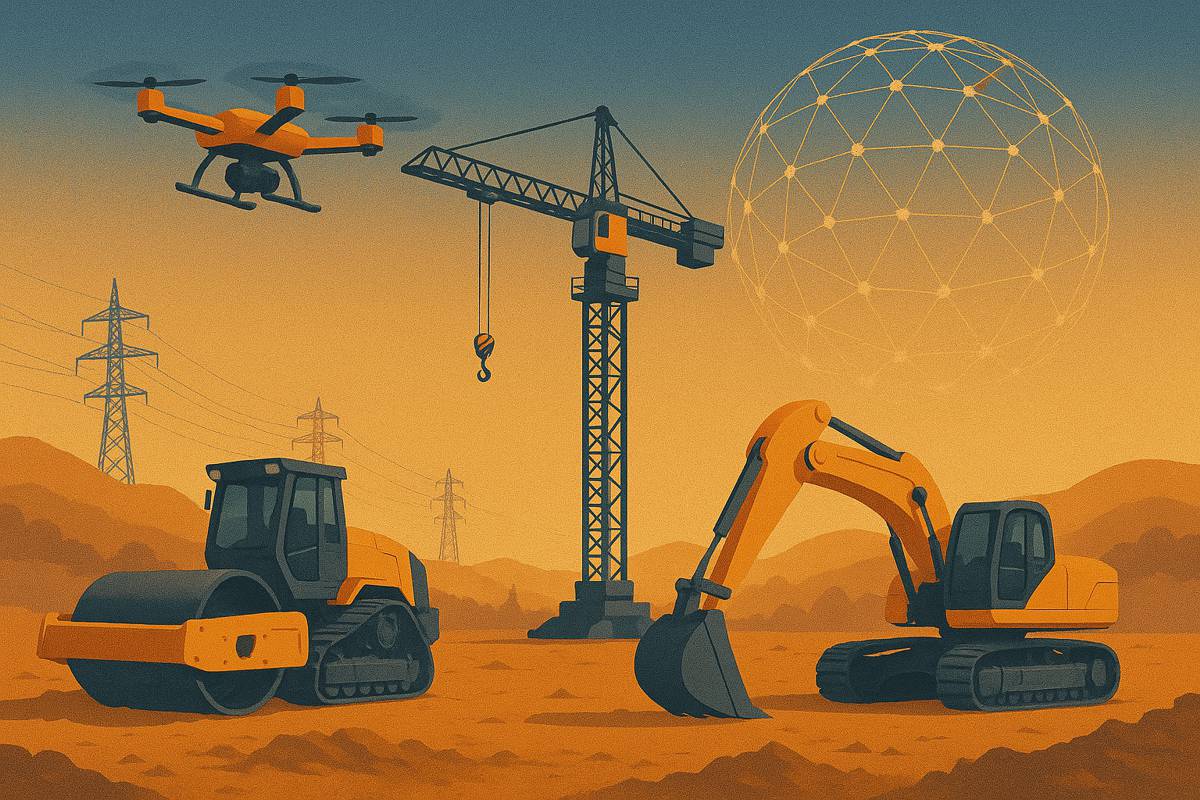
The Human Impact – Workforce Reskilling and Evolving Roles
With all the talk of robots, AI and autonomous this-or-that, an underlying question arises: what about the people? Construction has always been a people-driven industry, employing millions in skilled and unskilled roles. As technology disrupts traditional ways of working, there’s understandable concern about job displacement. However, industry leaders and researchers emphasise that the future is not about replacing humans, but augmenting and elevating the workforce. In fact, far from making construction less human, the consensus is that these innovations could address labour shortages, make jobs safer, and even attract a new generation of talent – if managed correctly.
Reskilling and upskilling are the buzzwords of this transition. Essentially, the workforce needs new skills to work alongside technology. Operators who once relied purely on muscle memory and levers now must be comfortable with touchscreens, software interfaces, and interpreting data readouts.
Training programs are cropping up to meet this need:
Simulator Training: Many equipment OEMs now offer simulator systems that resemble an arcade video game version of an excavator or crane. Trainees use realistic controls and VR displays to learn how to operate modern machinery (including the use of automation features) in a safe, virtual environment. These simulators can accelerate learning and even score the operator’s efficiency and safety, pinpointing areas to improve. They are also crucial for training on autonomous or semi-autonomous operations – for example, learning how to supervise multiple machines from a control station.
Digital Academies: Companies like Caterpillar and Komatsu have set up operator training academies that include digital curriculum. Cat’s university programs include courses on using Cat Grade with 3D plans, or how to run and interpret telematics reports. Komatsu, via its distributors, has mobile training vans in some regions where they bring a couple of simulators and a classroom to a customer’s site to train their crew on new Smart Construction tech. Likewise, unions and trade schools are evolving curricula. The International Union of Operating Engineers (IUOE) in the U.S. has added GPS machine control and basic robotics to the training at some of its locales, ensuring apprentices learn both the old-school and new-school methods.
Upskilling on the Job: Some contractors are deliberately pairing tech-savvy younger crew with veteran operators. The idea is the younger person might handle the digital aspects (programming a machine’s work plan, managing drone surveys, etc.) while the veteran focuses on the machine’s operation and imparts real-world knowledge. Over time, each learns from the other – the veteran picks up digital skills; the younger worker gains field wisdom. This kind of mentorship-based upskilling keeps experienced workers relevant and helps new entrants gain confidence faster.
Industry strategies to prevent displacement tend to focus on transitioning workers into new roles rather than laying them off. For example, when a company like Built Robotics retrofits an excavator to be autonomous, they often train the original operators to become robotic equipment supervisors. Instead of physically driving one excavator, that operator might now oversee 2–3 automated ones, intervening only when the AI encounters something it can’t handle. Tim Crane from Caterpillar even envisions future operators evolving into “commanders overseeing fleets of machinery” from a control hub. In many cases, the limiting factor to deploying more automation isn’t the tech itself, but having people trained to use it effectively. So companies are highly incentivised to retrain their workforce.
Another human dimension is that automation can make construction careers more attractive by changing the nature of the work. The job of an excavator operator, for instance, could shift from long hours sitting in a vibrating, noisy cab to more of a tech-enabled position in an air-conditioned operations centre. This can prolong the careers of older operators (less physical strain) and appeal to younger workers who grew up with video games and computers. One often-cited statistic by industry groups is that by 2030, a significant portion of the construction workforce will retire – automation can capture their knowledge in systems while also compensating for fewer new workers entering.
To protect workers, some regions are considering policies or agreements to manage the transition. Unions in Europe have proposed frameworks where if a task is automated, affected workers are guaranteed training for another role in the company (be it maintaining the robots or other skilled work). Governments are also funding tech education: for example, the Singaporean government offers grants for construction firms to train their staff in BIM and robotics, under the condition that no jobs are lost due to the tech adoption but rather redefined.
There are certainly concerns – a study by the Midwest Economic Policy Institute estimated that by 2057, robots could displace or replace 2.7 million construction jobs in the U.S. if technology keeps advancing at the current pace. But that’s a worst-case scenario assuming no mitigation. Experts argue that new jobs will emerge: robot maintenance technicians, drone pilots, data analysts, software trainers, digital model coordinators, and more. These were not common roles on sites a decade ago, but now some large projects have them. A concrete example is the rise of the “BIM coordinator” on construction projects; similarly, we may see titles like “Autonomous Equipment Fleet Manager” become a standard role.
The changing role of the operator is perhaps the most significant near-term shift. Rather than being in the machine, they might operate remotely or oversee multiple machines. They might need to trust and understand what the AI is doing, intervening only when necessary – which requires a different mindset, more akin to an airline pilot managing an autopilot. Operators will also interact more with digital systems: confirming a work plan, reviewing sensor alerts, etc. This is a skill set that blends operational know-how with a comfort in using software tools.
Finally, the industry is keenly aware that technology can improve safety and job quality for workers. Robots taking over the three D’s – jobs that are dirty, dangerous, or dull – means workers can focus on supervision and more complex tasks. Fewer people in harm’s way, fewer injuries from heavy lifting or repetitive strain, and hopefully a reduction in the fatality rates. The CDC’s NIOSH research on construction robotics suggests that if done thoughtfully, automation could significantly reduce work-related musculoskeletal disorders and exposure to hazards. So the narrative is increasingly that automation and AI will make construction safer and even “more human”, by letting humans do what they’re best at (critical thinking, creativity, problem-solving) and leaving the drudgery or danger to machines.
In summary, reskilling the workforce is not just an afterthought – it’s central to the future of construction. Companies, unions, and governments are collaborating to ensure that those who build our world aren’t left behind in the tech revolution. The transition is in its early stages, but success stories are emerging of crews that have embraced new tools and found they can do more, with less sweat and risk, than before.
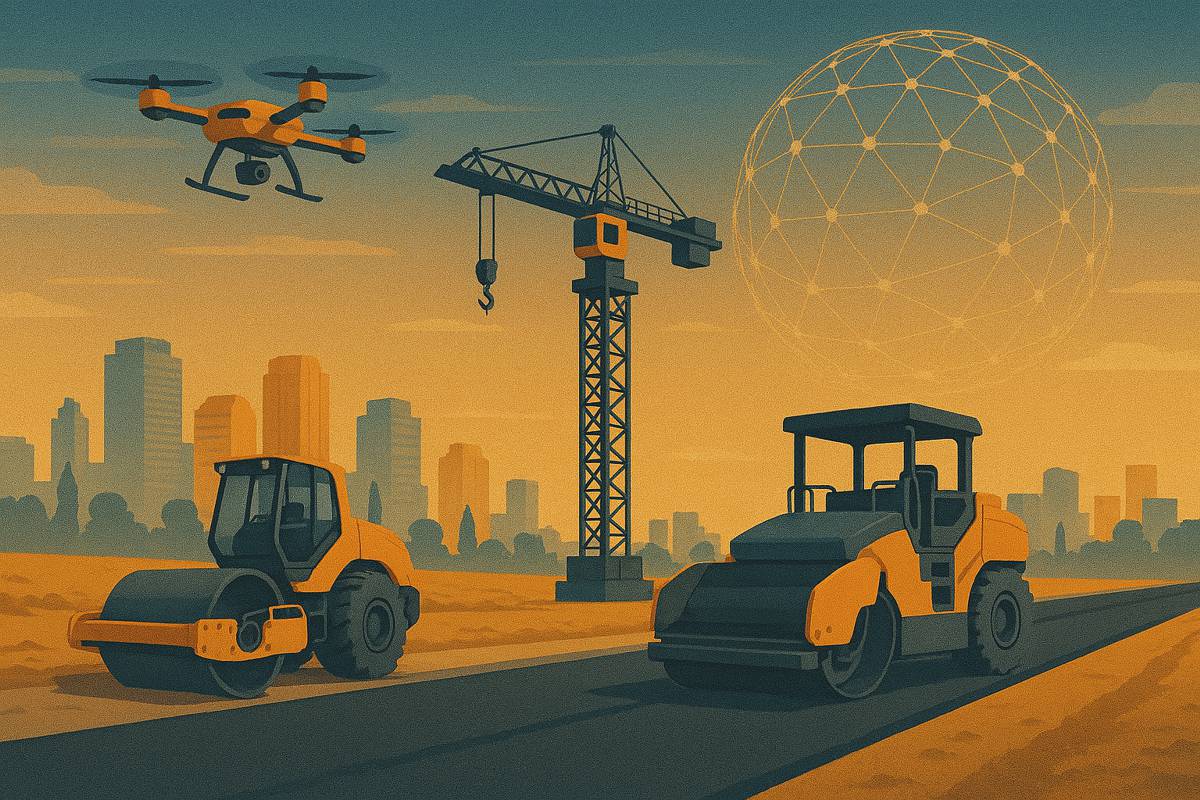
High-Tech Jobsites Today – Pilots and Projects Paving the Way
While some of this talk of autonomous, connected, future construction equipment and AI-driven construction may sound futuristic, it’s important to recognise that the future is already here – it’s just not evenly distributed. Around the world, pioneering projects are offering a glimpse of what tomorrow’s jobsite could look like. These real-world implementations serve as living laboratories, testing advanced tech in harsh construction conditions and proving their value.
Let’s visit a few of these next-generation construction sites making waves:
The Electric Site Project – Sweden: Volvo CE, in partnership with Skanska, conducted a famous pilot known as the Electric Site at a quarry near Gothenburg. In this project, a fleet of prototype electric and autonomous machines (including HX02 load carriers, electric hybrid wheel loaders, and cable-connected excavators) handled all quarry operations for 10 weeks. The result was a 98% reduction in carbon emissions and 70% lower energy cost compared to a conventional setup, along with a 40% reduction in operator hours on site. This 2018/2019 project was one of the earliest to integrate electrification with automation; its success has influenced Volvo’s product roadmap and shown that a nearly emissions-free, largely automated site is feasible. One insight from the Electric Site was how coordination between machines becomes crucial – so Volvo developed a control system to manage the swarms of electric haulers, a precursor to today’s TARA system.
Autonomous Solar Farm Construction – USA: In California’s Central Valley, a construction tech start-up, Built Robotics, has been retrofitting standard bulldozers and excavators with autonomy kits and deploying them on solar farm projects. These projects involve repetitive grading and trenching over hundreds of acres – an ideal scenario for automation. On one such solar farm build in 2024, autonomous dozers worked 20-hour days (with 4 hours for charging and maintenance), considerably longer than human-operated shifts could be. They achieved roughly 30% more progress per week than a traditional crew, according to the project manager’s report. A human safety steward was on site (able to take remote control if needed), but in general, the machines proved capable of following the digital terrain model accurately. The success led the contractor to immediately invest in more autonomy kits. This kind of application shows the near-term sweet spot for autonomy: large, semi-structured sites with repetitive tasks and a hunger for faster delivery.
Robotic Tunnel Boring and Mapping – Asia: On a metro tunnel project in Singapore, contractors experimented with a combination of automated equipment and AI-based monitoring. A robotic shotcrete sprayer (spraying concrete on tunnel walls) was used to coat tunnel sections, guided by LIDAR scans to ensure even coverage. Meanwhile, drones equipped with scanners flew behind the tunnel boring machine (TBM) to do mapping and check for defects or settling in real time. The data was instantly analysed by an AI for any anomalies. This integration meant that by the time a tunnel segment was excavated, there was already a detailed assessment of its condition, all without sending surveyors into the fresh tunnel. It improved safety and shaved weeks off the schedule by catching issues early. Singapore’s drive towards “Industry 4.0” in construction has made it a hotbed for such multi-tech integrations on sites.
HS2 Rail Project – United Kingdom: HS2, the high-speed rail line under construction in the UK, has been a testing ground for numerous innovations. From AI-based progress tracking with drones to AR for site inspections, it has tried it all. Notably, HS2 used 3D printed concrete elements in some works and deployed virtual reality for worker training (especially for safety scenarios). They also trialled an autonomous excavator (developed by a consortium including Skanska and ABB) for remote digging in a particularly tricky section under ancient woodland, where precision was paramount to avoid disturbing roots. The autonomous excavator performed delicate grading tasks slower than a skilled operator might, but extremely precisely, validating the idea that autonomy can be advantageous for fine, risk-sensitive work as well as bulk moves.
Smart Road Construction – China: A highway project in Zhejiang province utilized an AI system to coordinate 100+ pieces of equipment. Each machine was IoT-connected and fed status data to a central platform (developed by Alibaba Cloud). The AI “dispatcher” allocated tasks – e.g., directing certain trucks to which paver or adjusting the work zones of excavators to avoid conflicts. This was paired with a digital twin of the project, updated in real time. The project finished 10% faster than similar ones, and importantly, had zero accidents – something the project leads attribute to the AI’s ability to predict and prevent risky situations by controlling the flow of work. It effectively removed human communication delays and errors from the equation. This is a bold example of trusting AI with operational decision-making on site, and it points to how future projects might be run more like optimized networks.
Mining Automation Crossover – Australia: In Western Australia’s Pilbara region, mining company Rio Tinto operates fully autonomous iron ore mines with self-driving trucks, automated drilling rigs and remote-operated loaders. In 2025, some of this tech “crossed over” to a related infrastructure project: the expansion of a port facility and rail line to ship that ore. The construction team used Caterpillar’s autonomous haul trucks to move earth for the rail embankments, working in tandem with traditional construction equipment. The autonomous trucks moved over 1.5 million tonnes of material with virtually no incidents and were overseen from the same remote operations centre that handles the mine, 1,500 km away in Perth. This demonstrated that autonomous gear isn’t limited to mining pits – it can be leveraged in civil construction with minor adjustments. It also showcased how centralised operations centres might manage multiple projects’ equipment in the future, almost like an air traffic control for construction.
These examples barely scratch the surface, but they underscore a pattern: pilot projects consistently show improvements in safety, efficiency or sustainability (often all three). They also surface practical lessons – for instance, a common finding is that connectivity (good wireless networks on site) is crucial for these systems to work reliably. Another lesson is the need for collaboration: tech firms, equipment makers, and contractors often partner closely on these pilots, blending expertise in ways traditional contracting hasn’t seen before.
One more subtle outcome of these pilots is cultural change. The crews involved often become ambassadors for the new technology. A dozer operator who worked with the autonomous system might tell peers, “It’s not here to take our jobs – it made our job easier and the project faster, and we were still needed to guide it.” These real voices help dispel myths and build acceptance industry-wide.
For sceptics, seeing is believing. As more case studies from pilot projects circulate at conferences and in media, the idea of a high-tech jobsite moves from fantasy to something tangible and competitive. We’re reaching a tipping point where companies feel they could be left behind if they don’t at least experiment with these advancements. And thus the momentum builds.
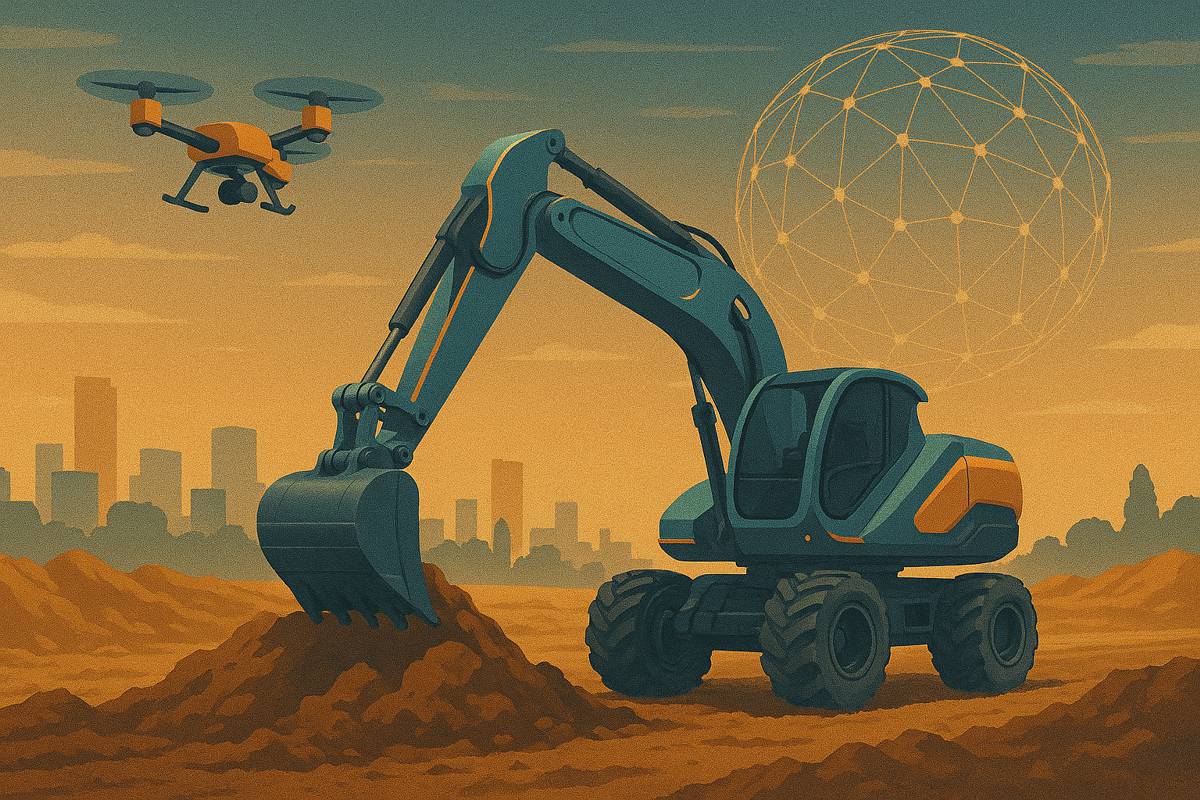
Tomorrow’s Jobsite – Smarter, Safer, and More Human
Fast forward to 2035 or 2040 – what might a construction site look like? While nobody has a crystal ball, current trends and pilots allow us to envision a grounded yet inspiring scenario for the jobsite of the future. Importantly, this vision isn’t about removing humans from the picture; rather, it’s about leveraging technology to create a smarter, safer, and more human-centred workplace.
Imagine a morning on a construction site in 2035: As the sun rises, a fleet of electric machines has already begun work at dawn, having charged overnight from on-site renewable energy storage. The site manager arrives not to a chaotic scene, but to a digital dashboard – a living “mission control” digital twin of the project. Every vehicle, drone, and piece of equipment is represented in this 3D model, updating in real time.
Before work started, an AI system optimised the day’s plan, scheduling the sequence of tasks and allocating resources in the most efficient way. It even consulted the weather forecast and adjusted the plan to move indoor or covered tasks earlier because rain is expected in the afternoon (something project managers do today, but tomorrow’s AI assistant handles it automatically at 3am). The AI suggested moving two autonomous excavators to a different quadrant to finish trenching there faster and avoid upcoming interference with the concrete pour crew – a coordination that would be hard to spot manually.
Advanced robotics are commonplace: nimble robot arms tie rebar and lay bricks with precision. Drones buzz overhead, not just mapping but carrying small loads and serving as roving security and safety inspectors. Perhaps a Boston Dynamics-style quadruped robot trots around carrying tools and scanning for safety issues, seamlessly navigating the rough terrain. These robots handle the mundane and dangerous, while human workers focus on installation, quality checks, and complex decision-making.
Every worker on site wears a comfortable smart hardhat with an Augmented Reality visor. Through the AR display, they can see instructions, like the exact cut line on a floor marked virtually, or the planned route of an underground utility highlighted beneath the soil – no more digging blind and hitting unknown cables. If a less experienced worker is unsure how to assemble a formwork, they can pull up a holographic overlay showing the assembly steps right on the structure, or even call a remote expert who can sketch guidance onto their AR view. VR and AR have blurred into the daily routine – with VR used in morning briefings to quickly walk through the day’s critical tasks in simulation, so everyone is on the same page about how to execute.
The equipment itself is nearly unrecognisable from decades prior. The excavators, dozers, and cranes are all either electric or hydrogen-powered, emitting zero pollutants. They operate in near silence aside from the sounds of actual construction (cutting, etc.), making communication on site easier and the environment less stressful. Most heavy machines run in autonomous or semi-autonomous mode, with operators supervising multiple units from a central cab. One operator might oversee a cut/fill operation with three bulldozers working in unison, orchestrated by an AI that ensures they don’t collide and that they follow the design grade precisely. The operator intervenes only if something unexpected occurs, or when fine-tuning is needed around edges. This multitasking ability means fewer operators can accomplish more work, and those operators are in safer, climate-controlled environments.
Real-time digital twins ensure that as the construction progresses, the digital model of the structure updates, and any deviations are caught early. Sensors embedded in concrete inform the twin that a pour has cured to 70% strength, triggering the next stage to proceed. If a steel beam is installed slightly out of alignment, laser scanners catch it and the system alerts the team to correct it before it compounds into a bigger issue. Quality control becomes a continuous process rather than something done after the fact.
Crucially, the site is safer than ever. AI-powered monitoring means that if a person is somewhere they shouldn’t be (too close to a robot or under a suspended load), automated systems either slow down the work or sound an alert. Robots have “safety brains” to constantly watch out for humans – fulfilling standards that were just being drafted in the 2020s. The environment is also healthier – no diesel soot in the air, far less noise, and ergonomic exoskeleton suits available for any heavy manual lifting tasks, reducing strain on workers’ bodies. By 2040, one could expect construction accidents to be rare events, as uncommon as accidents in manufacturing plants became once automation and strict safety interlocks took root.
From a human perspective, the jobsite of the future is more collaborative between humans and machines. Workers often operate in tandem with robots – for example, an installer might use a robotic assistant that holds a heavy panel in place (like a third hand) while they fasten it, something already piloted with drywall-installing robots. There’s a strong emphasis on skill diversification: a crew member might fly a drone to inspect something, then switch to guiding a robot, then do a bit of manual finishing work, all in one day. It’s a far cry from standing at one station repeating a task. This variety can make the work more engaging and reduce fatigue from repetition.
Sustainability is also front and centre. The high-tech jobsite doesn’t just build smarter, it builds greener. Materials are tracked to ensure minimal waste – AI models optimised the cut patterns and ordering so little ends up in the dumpster. Any scrap that is generated is immediately logged and sorted by robots for recycling or reuse. The machinery itself optimises energy use: idle time is virtually eliminated because AI shuts machines off when not needed and schedules their tasks efficiently. Even on-site temporary facilities are smart – solar panels and battery banks power the site hut and electric vehicle chargers for workers’ cars, making the whole operation as close to carbon-neutral as possible.
What about the workforce in 2035-2040? By then, a new generation of construction professionals will have grown up in this digital-physical convergence. Job titles like “Construction Robotics Technician”, “AI Construction Supervisor”, or “Digital Twin Modeler” might be common. But traditional roles won’t vanish; they’ll adapt. An experienced carpenter in 2040 might use AR glasses to perfectly align joints and employ robot helpers, but their knowledge of how to achieve a quality finish is still crucial. In fact, skilled trades could become more valued as the basic labour gets automated – the human touch for fine craftsmanship, troubleshooting unique problems, and creative adaptation to changes will stand out. The hope is that by automating the grunt work, construction careers become more about brain and less about brawn, attracting a broader talent pool including more women and others who historically might have been deterred by the extreme physicality of the work.
Companies will also take on new forms. Perhaps we’ll see construction tech integrators – firms that specialise in providing turnkey high-tech construction crews (robots + trained humans + software) to projects. Existing contractors may evolve to have in-house tech divisions. The ones who embraced change early, retrained their people, and cultivated a culture of innovation will likely be industry leaders by 2040.
Finally, safeguards will be in place to ensure human welfare is protected amidst all this tech. There will likely be regulations requiring human oversight of critical tasks (no fully unsupervised building of load-bearing structures, for instance, to prevent an AI mistake from going unchecked). Ethical use of AI – making sure decisions like scheduling don’t inadvertently overwork people or that algorithms aren’t biased against certain workers – will be important, and perhaps overseen by compliance officers.
In this envisioned tomorrow, the construction site is not a chaotic tangle of risk and toil, but a harmonised environment where humans and machines each contribute their strengths. The machines handle the 4D tasks (dull, dirty, dangerous, and now data-heavy) and humans provide the 4C’s (critical thinking, creativity, craft, and compassion). Instead of displacing humans, technology elevates them – making construction work more intelligent, safe, and yes, more human in the sense that people can focus on what humans excel at.
The path to 2035 and beyond will undoubtedly face hurdles – technical, economic, and social. But as we’ve explored, the industry is already stepping into that future one innovation at a time. From AI predicting maintenance to robots laying bricks, the foundation is being laid for a new era of construction. And at the heart of that era is the goal of building smarter and safer while keeping the human element paramount. The jobsite of tomorrow promises to be an exciting place: one where advanced technology and human ingenuity work side by side to create the buildings and infrastructure of the future.
